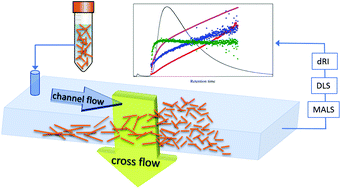Separation and characterization of cellulose nanocrystals by multi-detector asymmetrical-flow field-flow fractionation†
Abstract
Cellulose nanocrystals (CNCs) are renewable, naturally derived polymeric nanomaterials receiving substantial attention for a wide range of potential applications. The recent availability of high quality reference materials will facilitate the development and validation of measurement methods needed to advance the scientific and commercial use of CNCs. In the present study, we demonstrate an optimized method to fractionate CNCs with narrow size dispersion based on asymmetrical-flow field-flow fractionation (AF4) coupled with on-line multi-angle light scattering (MALS), dynamic light scattering (DLS), and differential refractometry (dRI). A stable suspension of CNC (Certified Reference Material CNCD-1, National Research Council-Canada) in deionized water was prepared using a dispersion method provided by NRC and adopted from a protocol originally developed at the National Institute of Standards and Technology. The as-prepared material was initially characterized in batch mode to validate the NRC dispersion method. AF4 was then optimized for channel and cross flow, mobile phase composition, and injection volume, among other parameters. Additionally, suspensions containing (1.25–10) mg mL−1 CNC were injected directly into the dRI detector (off-line), yielding a dn/dc value of 0.148 ± 0.003 mL g−1. dRI was then used as an on-line mass sensitive detector to quantify recovery. Results show that maximum recovery (≈ 99%) was achieved under optimized conditions. The weight-averaged molar mass (Mw) was estimated at roughly 107 Da from a partial Zimm analysis. The optical radius of gyration, Rg, and the hydrodynamic radius, Rh, were measured during elution. The shape factor (Rg/Rh) ranged from 1.5 to 1.9 for the fractionated material, supporting an elongated or rod-like structure. To our knowledge, this is the first time that both the morphology and molar mass of CNCs have been directly measured for the full distribution of species. Finally, we developed and demonstrated a semi-preparatory fractionation method to separate CNCs at the milligram scale for off-line research and analysis.



 Please wait while we load your content...
Please wait while we load your content...